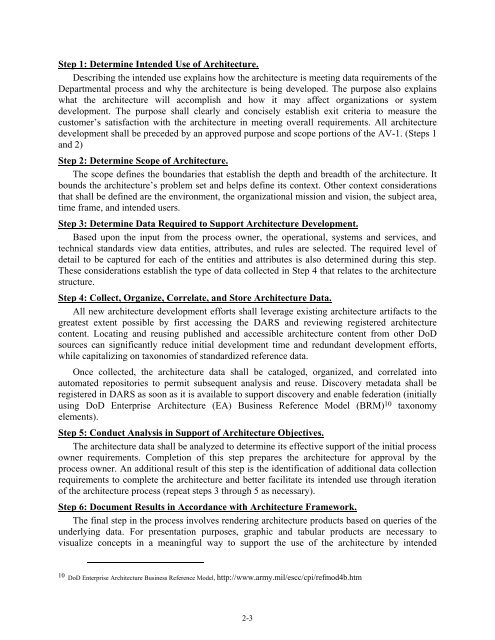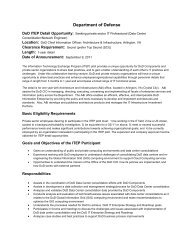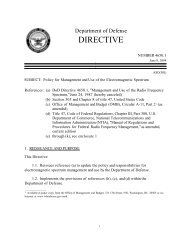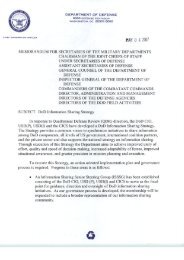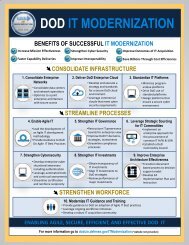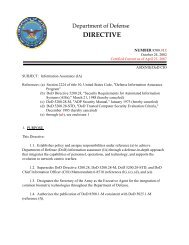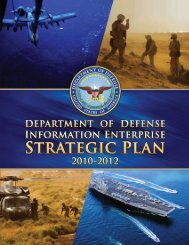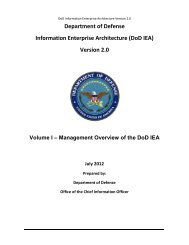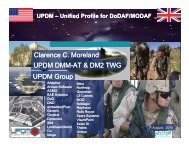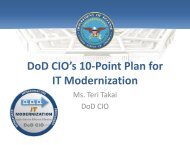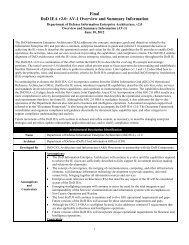DoD Architecture Framework Version 1.5 - Chief Information Officer
DoD Architecture Framework Version 1.5 - Chief Information Officer
DoD Architecture Framework Version 1.5 - Chief Information Officer
Create successful ePaper yourself
Turn your PDF publications into a flip-book with our unique Google optimized e-Paper software.
Step 1: Determine Intended Use of <strong>Architecture</strong>.<br />
Describing the intended use explains how the architecture is meeting data requirements of the<br />
Departmental process and why the architecture is being developed. The purpose also explains<br />
what the architecture will accomplish and how it may affect organizations or system<br />
development. The purpose shall clearly and concisely establish exit criteria to measure the<br />
customer’s satisfaction with the architecture in meeting overall requirements. All architecture<br />
development shall be preceded by an approved purpose and scope portions of the AV-1. (Steps 1<br />
and 2)<br />
Step 2: Determine Scope of <strong>Architecture</strong>.<br />
The scope defines the boundaries that establish the depth and breadth of the architecture. It<br />
bounds the architecture’s problem set and helps define its context. Other context considerations<br />
that shall be defined are the environment, the organizational mission and vision, the subject area,<br />
time frame, and intended users.<br />
Step 3: Determine Data Required to Support <strong>Architecture</strong> Development.<br />
Based upon the input from the process owner, the operational, systems and services, and<br />
technical standards view data entities, attributes, and rules are selected. The required level of<br />
detail to be captured for each of the entities and attributes is also determined during this step.<br />
These considerations establish the type of data collected in Step 4 that relates to the architecture<br />
structure.<br />
Step 4: Collect, Organize, Correlate, and Store <strong>Architecture</strong> Data.<br />
All new architecture development efforts shall leverage existing architecture artifacts to the<br />
greatest extent possible by first accessing the DARS and reviewing registered architecture<br />
content. Locating and reusing published and accessible architecture content from other <strong>DoD</strong><br />
sources can significantly reduce initial development time and redundant development efforts,<br />
while capitalizing on taxonomies of standardized reference data.<br />
Once collected, the architecture data shall be cataloged, organized, and correlated into<br />
automated repositories to permit subsequent analysis and reuse. Discovery metadata shall be<br />
registered in DARS as soon as it is available to support discovery and enable federation (initially<br />
using <strong>DoD</strong> Enterprise <strong>Architecture</strong> (EA) Business Reference Model (BRM) 10 taxonomy<br />
elements).<br />
Step 5: Conduct Analysis in Support of <strong>Architecture</strong> Objectives.<br />
The architecture data shall be analyzed to determine its effective support of the initial process<br />
owner requirements. Completion of this step prepares the architecture for approval by the<br />
process owner. An additional result of this step is the identification of additional data collection<br />
requirements to complete the architecture and better facilitate its intended use through iteration<br />
of the architecture process (repeat steps 3 through 5 as necessary).<br />
Step 6: Document Results in Accordance with <strong>Architecture</strong> <strong>Framework</strong>.<br />
The final step in the process involves rendering architecture products based on queries of the<br />
underlying data. For presentation purposes, graphic and tabular products are necessary to<br />
visualize concepts in a meaningful way to support the use of the architecture by intended<br />
10 <strong>DoD</strong> Enterprise <strong>Architecture</strong> Business Reference Model, http://www.army.mil/escc/cpi/refmod4b.htm<br />
2-3


